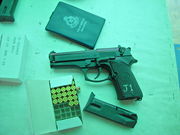Beretta 92
| Beretta 92 | |
|---|---|
 Beretta 92FS |
|
| Type | Semi-automatic pistol |
| Place of origin | |
| Service history | |
| In service | 1975-present |
| Used by | See Users |
| Production history | |
| Manufacturer | Fabbrica d'Armi Pietro Beretta |
| Produced | 1975–present |
| Variants | See Variants |
| Specifications | |
| Weight |
|
| Length |
|
| Barrel length |
|
|
|
|
| Cartridge |
|
| Feed system | Detachable box magazine:
|
The Beretta 92 (also Beretta 96 and Beretta 98) is a series of semi-automatic pistols designed and manufactured by Beretta of Italy. The model 92 was designed in 1972 and production of many variants in different calibers continues today. The United States armed forces replaced the M1911 .45 ACP pistol in 1985 with the M9.
Although only 5000 copies of the original design were manufactured from 1975 to 1976, the design is currently produced in four different configurations (FS, G, D and DS) and four calibers:
- 92 series in 9x19mm Parabellum
- 96 series in .40 S&W
- 98 series in 9x21mm IMI
- 98 and 99 series in 7.65mm Luger
Contents |
History
The Beretta 92 pistol evolved from earlier Beretta designs, most notably the M1922 and M1951. From the M1922 comes the open slide design, while the alloy frame and locking block barrel (originally from Walther P38) were first used in the M1951. The grip angle and the front sight integrated with the slide were also common to earlier Beretta pistols.
The Beretta 92 first appeared in 1975[1] and was designed by Carlo Beretta, Giuseppe Mazzetti and Vittorio Valle, all experienced firearms designers on the Beretta design team.
92
About 5000 copies of the first design were manufactured from 1975 to 1976.
92S
In order to meet requirements of some law enforcement agencies, Beretta modified the Beretta 92 by adding a slide-mounted combined safety and decocking lever, replacing the frame mounted manual thumb safety. This resulted in the 92S which was adopted by several Italian law enforcement and military units. The later relocation of the magazine release button means these models (92 & 92S) cannot necessarily use later magazines, unless they have notches in both areas.
92SB (92S-1)
The extremely rare 92SB, Initially called the 92S-1, was specifically designed for the USAF (US Air Force) trials (which it won), the model name officially adopted was the 92SB. It included the changes of the 92S, added a firing pin block (thus the addition of the "B" to the name), and relocated the magazine release catch from the bottom of the grip to the lower bottom of the trigger guard.
- 92SB Compact (1981 – 1991), shortened barrel and slide (13-round magazine capacity). It was replaced by the "92 Compact L".
92F (92SB-F)
Beretta modified the model 92SB slightly to create the 92SB-F (the "F" added to denote entry of the model in U.S. Government federal testing) and, later, the 92G for French Government testing, by making the following changes:
- Design of all the parts to make them 100% interchangeable to simplify maintenance for large government organizations.
- Modified the front of the trigger guard so that one could use finger support for easier aiming.
- Recurved the forward base of the grip to aid aiming.
- Hard chromed the barrel bore to protect it from corrosion and to reduce wear.
- New surface coating on the slide called Bruniton, which allegedly provides better corrosion resistance than the previous plain blued finish.
92FS
The FS has an enlarged hammer pin that fits into a groove on the underside of the slide. The main purpose is to stop the slide from flying off the frame to the rear if it cracks. This was in response to reported defective slides during US Military testing.
Design
The Beretta 92's open slide design ensures smooth feeding and ejection of ammunition and allows easy clearing of obstructions. The hard-chromed barrel bore reduces barrel wear and protects it from corrosion. The locking block barrel lockup provides good accuracy and operability with suppressors due to the in-line travel of the barrel. This is in contrast to the complex travel of Browning designed barrels. The magazine release button is reversible with simple field tools. Reversing the magazine release makes left-handed operation much easier.
Increasingly, it has become popular to reduce handgun weight and cost (and increase corrosion resistance) using polymers, and polymer parts have started showing up in Beretta 92/96 models too. In 2003, the first internal polymer part to be introduced was a recoil spring guide. New polymer parts include safety lever, trigger, mainspring cap, magazine floorplate, and follower. In contrast some parts have been painted black to match the included polymer parts, these include; slide release, disassembly latch, and hammer.
The 92 also spawned several variants of similar internal design. The Beretta 90two is a full-size variant of the 92-series with a redesigned frame, slide, and grip, and has an accessory rail.
Variants

The Beretta 92 is available in many configurations each with a distinct model name. Combining the various options results in more than 50 different configurations, but the major variants are defined by their operation caliber (92/96/98), operation (F/G/D) and combination of optional items (Inox/Brigadier slide/Compact length):
Calibers
Each model name starts with two digits identifying the caliber:
- 92
- Chambered for the 9x19mm Parabellum.
- 96
- Chambered for the .40 S&W, introduced in 1990.
- 98
- Chambered for 9x21mm IMI. This option was introduced in 1991 for markets where it is illegal to own a weapon chambered for a military cartridge such as 9x19mm - essentially, this is the case of Italy. There were also about 5000 early 98F manufactured in .30 Luger.
Operation
- F Models
- Also known as the 92SB-F, the model 92 F was developed in 1983 as a further modification of the model 92 SB that featured a slightly reshaped grip, plastic grip panels and a new, more durable finish. The current production version of the 92 F has a double-action first trigger pull, followed by a single-action trigger pull for subsequent rounds. The "F" and "FS" models have a safety lever that also functions as a decocking lever. The 92 FS was submitted for USA XM9 Army Pistol Trials in 1985 and adopted by the US Army as the M9 Pistol. It is manufactured both in Italy and in USA, and has also been adopted by many other military and law enforcement groups. The 92 FS features a chrome-lined barrel, recurved triggerguard for improved two-handed grip, new grip panels and lanyard ring, Bruniton finish, and trigger bar disconnect safety.
- G Models
- The G models (designed for the French "Gendarmerie Nationale") were adopted by the French Military as PAMAS ; they feature a manual decocking lever only instead of the safety-decocking lever of the 92 FS. When the decocking lever is released, it automatically returns to the ready to fire position. There is no manual safety.
- DS Models
- The DS models are "double action only" pistols: the hammer always follows the slide forward to come to rest in the double action position (the hammer never stays cocked). The hammer spur has been removed, and is flush with the rear of the slide. The manual safety lever on the slide provides the same function as it does on the 92 FS.
- D Models
- The D models are also "double action only" pistols. They are identical to the DS models but without the manual safety (the lever has also been eliminated).
- Centurion Models
- These pistols offer the frame (and same magazine capacity) of the basic 92 FS model and the reduced length of the Compact version. Special G Centurion, DS Centurion and D Centurion models are available in some countries.
- Competition Conversion Kit Models
- The standard model can be converted with a special conversion kit into a competition target pistol. The kit includes a 7.3 in (190 mm) barrel with counterweight and elevated front sight, a fully-adjustable target rear sight and ergonomic walnut grips.
- Target Models
- Designed for competition shooting, these models meet all U.I.T.S. standards for large caliber pistols (P.G.C.). They differ from basic 92 FS in the following aspects: 150 mm (5.9 in) barrel, with aluminum counterweight sleeve, fully-adjustable target rear sight, ergonomic walnut grips with "orange peel" anti-slip finish.
- Inox Models
- The Inox models (from the Italian "inoxidable" meaning non-oxidizing) feature the following parts made in stainless steel: the barrel, the slide (including the extractor, the safety and the right-side manual safety lever), the trigger (and trigger pin), and slide stop lever.
Options
- Vertec
- (2003 –)
- New vertical grip.
- Short-reach trigger.
- Thinner grip panels.
- Integral accessory rail.
- Removable front sight (can be replaced with Tritium sight).
- Beveled magazine well (to enable easier/faster reloading).
- Brigadier
- (1993 – 2006)
- 60 grams (2.1 oz) heavier slide (and 1 millimetre (0.04 in)wider) to improve control when firing multiple shots in quick succession. It also includes removable front and rear sights.

- Elite I
- (1999 – 2001)
- Pistols with this option include the heavier Brigadier bruniton slide with front serrations and Elite designation, Inox finish (silver) stainless barrel, thin skeletonized hammer, and bevel of the magazine well. A flat hammer spring cap was standard as well as the decock only (G-Model) feature and dovetailed front sight. It was introduced in 1999 and replaced by the Elite II option in 2001.
- Elite IA
- (2001 – 2006)
- This option is essentially a black Vertec with a bruniton Brigadier G slide having the Elite 1A designation and a thicker skeleton hammer. The 4.7" stainless barrel with Inox finish was also changed to the blackened stainless version like black Vertecs.
- Elite II
- (2001 – 2006)
- This option replaced the Elite I option in 2001 and includes the same features as the original Elite plus removable Novak type sights, extended magazine release catch, checkered front/rear grip strap, thicker (than Elite I) skeletonized hammer, and lighter D-spring. This option is available only with the stainless G-Model slide, also with front serrations. The stainless barrel for the Elite II has a target crown.
- Inox
- (present)
- Stainless barrel and slide (frame anodized to match color). Can have either black or stainless controls.
- Compact L
- (1992 –)
- Shorter barrel, slide, and more compact frame (13-round magazine capacity).
- Compact Type M
- (1992 –)
- Similar to the Compact L, but has a slimmer grip that accepts only a single stacked 8-round magazine.
- Centurion
- (1992 – 1997)
- Shorter barrel and slide (like "Compact"), but with standard-sized frame that has a slightly shorter dust cover.
- CB
- (1992 – 1993)
- Single action only. It is designed for sport shooting and includes a front barrel bushing for improved accuracy.
- Stock
- (1994 –)
- Heavier Brigadier slide. It is also designed for sport shooting and includes a front barrel bushing for improved accuracy.
- Combat
- (1994 – 2001)
- Heavier Brigadier slide, single-action only and also designed for sport shooting, including a front barrel bushing for improved accuracy. It also came with an additional longer barrel that was weighted.
- Billennium
- (2001 only)
- A limited-edition (2000 copies) commemorative (of the year 2000) model manufactured in 2001, featuring the heavier Brigadier slide.
- Steel I
- (2004 – 2006)
- Stainless steel, single-action-only, collector's model. [Edit: Both single-action-only and single/double-action variants exist. Also used and desirable for competitive shooting because of its steel frame (for added weight and strength), the frame-mounted safety and/or Vertec-style grip-frame that are all found to be desirable features in a competition gun.]
Magazine capacity
To keep in line with the introduction of laws in some locations restricting magazines that hold more than 10 rounds, Beretta now manufactures magazines that hold fewer than the factory standard 15 rounds. These magazines have heavier crimping (deeper indentations in the side) to reduce the available space while still keeping the same external dimensions and ensuring that these magazines can be used on existing firearms.
Italian magazine manufacturer Mec-Gar now produces magazines in blue and nickel finishes with a 18 round capacity, which fit flush in the magazine well on the 92 series. Mec-Gar also produces an extended 20 round blued magazine that protrudes below the frame by a 3/4 of an inch. These magazines provide users in unrestricted states with an even higher capacity.
93R
The Beretta 93R is a significantly redesigned 92 to provide the option of firing in three-round bursts. It also has a longer ported barrel, heavier slide, fitting for a shoulder stock, extra forward grip, and an extended magazine. Unlike other Berettas in the 90 series it is single-action only, does not have a decocker, and very few are around today.
92A1 and 96A1
A brand-new model of Beretta 92 series called 92A1, was introduced in 2010. It is based on the elements of 92FS and 90two. 92A1's overall shape and styling are based on 92FS with an accessory rail on the underside of the frame, while internal design is based on 90two. 96A1 is the variant of 92A1 chambered for .40 S&W. [2]
Taurus
The Beretta 92 was designed for sports and law enforcement use and, due to its reliability, was accepted by military users in South America. A large contract for the Beretta 92 was with the Brazilian army, for which Beretta set up a factory in Brazil. This factory was later sold to the Brazilian gunmaker Taurus. Taurus makes these pistols (called the PT92) without the need for a license from Beretta since their design is based on the original Beretta 92, whose patents have since expired. The PT92 can be distinguished from its Beretta counterpart primarily by having the safety mounted on the frame as opposed to on the slide like the Beretta, though PT92s are essentially identical to early Beretta 92s.
Users

 Algeria[3]
Algeria[3] Brazil: Brazilian Armed Forces.[3]
Brazil: Brazilian Armed Forces.[3] Chile[4]
Chile[4] Colombia[3]
Colombia[3] France: Standard issue pistol of the French Military, designated PAMAS G1 (Pistolet Automatique de la Manufacture d'Armes de Saint-Étienne, "automatic pistol of the Saint Etienne manufacture").[5] Also used by the Gendarmerie Nationale.[6]
France: Standard issue pistol of the French Military, designated PAMAS G1 (Pistolet Automatique de la Manufacture d'Armes de Saint-Étienne, "automatic pistol of the Saint Etienne manufacture").[5] Also used by the Gendarmerie Nationale.[6] India[3]
India[3] Indonesia: Komando Pasukan Katak (Kopaska) tactical diver group and Komando Pasukan Khusus (Kopassus) special forces group.[7]
Indonesia: Komando Pasukan Katak (Kopaska) tactical diver group and Komando Pasukan Khusus (Kopassus) special forces group.[7] Iran[4]
Iran[4] Iraq: Issued to units of the Iraqi Armed Forces (model 92FS).[8]
Iraq: Issued to units of the Iraqi Armed Forces (model 92FS).[8] Italy: Italian Armed Forces and various police forces.[6][9]
Italy: Italian Armed Forces and various police forces.[6][9] Jordan[3]
Jordan[3] Kuwait[3]
Kuwait[3] Luxembourg: Unité Spéciale de la Police of the Grand Ducal Police (92F).[10][11][12]
Luxembourg: Unité Spéciale de la Police of the Grand Ducal Police (92F).[10][11][12] Mexico: Various branches of the armed forces.[4]
Mexico: Various branches of the armed forces.[4] Morocco[3]
Morocco[3] Nigeria[3]
Nigeria[3] Pakistan: Special Service Group (SSG) of the Pakistan Army.[13]
Pakistan: Special Service Group (SSG) of the Pakistan Army.[13] Peru[3]
Peru[3] Slovenia: Slovenian Armed Forces (since 1991) and police.[14]
Slovenia: Slovenian Armed Forces (since 1991) and police.[14] Sudan[3]
Sudan[3] Turkey[3]
Turkey[3] United States: US Armed Forces since 1985.[6][9] Also used by the US Border Patrol,[3] US Immigration and Naturalization Service,[3] and Maryland State Police.[15]
United States: US Armed Forces since 1985.[6][9] Also used by the US Border Patrol,[3] US Immigration and Naturalization Service,[3] and Maryland State Police.[15] Venezuela[3]
Venezuela[3]
U.S. Military use


When the U.S. Air Force (USAF) began the Joint Service Small Arms Program, Beretta entered the competition. The Beretta 92SB (92S-1) won, but the Army contested the Air Force's methods. There would be several more competitions, and Beretta refined the design of the Beretta 92SB into the Beretta 92SB-F and in slightly modified form the Beretta 92G. These designs were ultimately selected by the United States (Beretta 92F, U.S. Military designation of M9 Pistol) and France (Beretta 92G, French military designation of "PAMAS"). The M9 Pistol was intended to replace the M1911A1 and .38-caliber revolvers and pistols. Over 500,000 M9 pistols were made and the switch-over was largely achieved.
The USAF has scheduled switching over from the early model M9 (92F) to the 92FS standard, according to planning documents. In May 2005, the U.S. Marine Corps (USMC) awarded a sole-source contract to Beretta for 3,480 "M9A1" pistols (M9 with an accessory rail, also available to the public from June 2006).
Beretta had two major contracts, about 500,000 units for the U.S. armed forces and about 230,000 units for the French armed forces. In the case of the Beretta 92G, it was agreed that the French would supply the slide steel to Italy until GIAT could start licensed production.
After a year of flawless production and testing of M9 pistols in Italy under U.S. Government supervision, testing and later production was transferred to the Beretta U.S.A. factory in Accokeek, Maryland. At the same time, the U.S. Army became responsible for providing 9 mm ammunition (called the M882 round) to support the testing. Using the new ammunition, problems with M9 test pistols began occurring. In some tests, the frames of the pistols showed microscopic cracks after firing 5,000 rounds during durability testing. Durability tested barrels showed a concentric indentation inside the chamber and, later, reports of slides breaking during field and test usage were reported.
Early analysis of the breakages by the Army suggested that the problems experienced were due to problems with the pistols themselves. Beretta responded to these reports by requesting testing of the M882 ammunition. Dissatisfied with the progress and methodology of the Army's tests of its ammunition, Beretta obtained independent tests of the ammunition that disclosed excessive pressure levels in the rounds (average pressures exceeding 345 MPa (50,000 psi), compared with the maximum NATO-allowed service pressure of 252 MPa (36,550 psi)).
After delays in delivery of M9 pistols while these issues were resolved, Beretta developed a safety mechanism (enlarged hammer pin head) that significantly reduced risk to the shooter should an M9 slide break. The U.S. Army also changed the propellant mix for the M882 round, after which no further pistol breakages of the types previously seen were reported.
During this same time and in years since, the U.S. Army conducted durability testing of M9 pistols at Aberdeen Proving Ground. These tests revealed an average life of the M9 frame at around 35,000 rounds, of the M9 locking block at around 22,000 rounds, and of the M9 slide at around 75,000 rounds, all well in excess of the contractually-required service life of 5,000 rounds for the pistol. In addition, Government-witnessed tests of the M9 pistol at the Beretta U.S.A. facility resulted in average reliability of the pistol at one malfunction every 17,500 rounds.
According to numerous accounts from founding members, the first US military unit to field the Beretta 92 was SEAL Team Six, however due to the extensive use of the pistol by SEAL Team Six (3000-5000 rounds per week, per operator), problems that were later evident with other US military users became apparent as slides started breaking and being flung back towards the shooter (reportedly due to use of over-pressure ammunition as described above).
See also
- Beretta 92 Models
- Beretta 93R
- Taurus PT92
Further reading
Blue Book of Gun Values, 26th Edition, S. P. Fjestad ISBN 1-886768-55-2
References
- ↑ Mod. 92FS : 15 years of evolution and success
- ↑ http://www.berettausa.com/products/model-92a1/default.aspx Beretta USA Website
- ↑ 3.00 3.01 3.02 3.03 3.04 3.05 3.06 3.07 3.08 3.09 3.10 3.11 3.12 3.13 Diez, Octavio (2000). Armament and Technology. Lema Publications, S.L. ISBN 84-8463-013-7.
- ↑ 4.0 4.1 4.2 Jones, Richard D. Jane's Infantry Weapons 2009/2010. Jane's Information Group; 35 edition (January 27, 2009). ISBN 978-0710628695.
- ↑ http://www.defense.gouv.fr/terre/decouverte/materiels/armement_individuel_et_collectif/pistolet_automatique_pamas_g1
- ↑ 6.0 6.1 6.2 Marchington, James (2004). The Encyclopedia of Handheld Weapons. Lewis International, Inc. ISBN 1-930983-14-X.
- ↑ "Kopassus & Kopaska - Specijalne Postrojbe Republike Indonezije" (in Croatian). Hrvatski Vojnik Magazine. http://www.hrvatski-vojnik.hr/hrvatski-vojnik/1612007/ind.asp. Retrieved 2010-06-12.
- ↑ Now on Duty
- ↑ 9.0 9.1 Miller, David (2001). The Illustrated Directory of 20th Century Guns. Salamander Books Ltd. ISBN 1-84065-245-4.
- ↑ "Unofficial Pistols Page, Equipment". http://USP.lu - Unofficial Website of Unité Spéciale, Officially Endorsed. http://www.usp.lu/armement-pistolets-fr.php. Retrieved 2009-10-06.
- ↑ "L'Unite d'Intervention de la Police Luxembourgeoise" (in French). RAIDS Magazine. March 2006. http://www.usp.lu/media/raids.pdf. Retrieved 2009-09-23.
- ↑ Lasterra, Juan Pablo (2004). "UPS Unidad Especial de la Policia Luxembourguesa" (in Spanish). ARMAS Magazine. http://www.usp.lu/media/armas.pdf. Retrieved 2009-09-23.
- ↑ "Pakdef.info — Pakistan Military Consortium: Special Service Group". Saad, S.; Ali, M.; Shabbir, Usman. 1998. http://www.pakdef.info/pakmilitary/army/regiments/ssg.html. Retrieved 2009-08-15.
- ↑ http://www.slovenskavojska.si/oborozitev-in-oprema/lahka-pehotna-in-podporna-oborozitev/polavtomatska-pistola-9mm/
- ↑ "Maryland State Police". http://recruiting.mdsp.org/training.asp.
External links
- Official Beretta 92 page
- Details on the Beretta 92
- A short story of the 92 and its derivatives
- Free videos of Beretta 92/96 disassembly
- How To Make The 92FS 9mm Shoot, Performance Shooter, October 1997
- Beretta 92F exploded-view parts diagram from American Rifleman
- Video of operation at YouTube (Japanese)